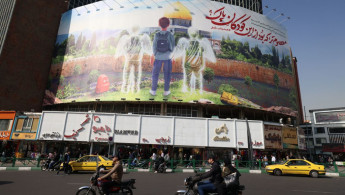Iran's covert Tehran meetings indicate readiness for military escalation with Israel
The article published on 7 November by Amwaj Media uncovering clandestine summertime meetings in Tehran among leaders of Iranian-backed armed groups in Iraq, Lebanon, Palestine, and Yemen has garnered attention in both the West and the Middle East.
However, Iranian analysts were unsurprised by the information disclosed in the piece.
Iranian media experts suggested that, given Amwaj Media's assumed affiliations, the article was a carefully crafted propaganda piece for a political manoeuvre, signalling to the US, its Western allies, and Israel that Iran is prepared to command a regional war by mobilising its proxies.
Amwaj's article, titled "The secret Arab visitors in Iran and the 'liberation' of Jerusalem," delved into intricate relationships, internal dynamics, and strategic considerations within armed groups supported by Iran in the Middle East.
It also provided details about internal disputes among Iraqi factions, power struggles, and disagreements over leadership positions, emphasising the role of Iran's Supreme Leader, Ayatollah Ali Khamenei, in unifying and commanding these militia groups.
Gregory Brew, author of "The Struggle for Iran" and "Petroleum and Progress in Iran," praised the article as a "fascinating report," noting corroborations of known information about Khamenei's role and the growing importance of Iran's intelligence ministry.
Tamer Badawi, a University of Kent PhD candidate specialising in conflict and governance in Iraq, commended the article on social media, stating, "Much more interesting details in this story about the alleged meeting between SL Khamenei and Iraqi paramilitary commanders. This is very good work from Amwaj Media."
Iranian media experts and foreign policy analysts offered a different perspective on the report despite Western fascination.
A veteran foreign policy journalist in Iran, speaking with The New Arab on condition of anonymity, suggested that the timing, details, and the outlet's identity make it likely that the Iranian regime and the Islamic Revolutionary Guard Corps (IRGC) aimed to send a warning message to the US regarding the potential spillover of the war in Gaza to the entire region.
"The core takeaway from this article is that a joint operations chamber in Tehran is strategically planning, organising, and orchestrating attacks in the region against the US, its allies, and Israel," the journalist pointed out.
According to this expert, despite reluctance to open new fronts against Israel by its proxies, Tehran seeks to make the war in Gaza come at a high price for the US and Israel, showcasing its military power in the region.
"I believe this piece serves as a clear message from the IRGC and the Iranian establishment to the US, asserting, 'We have not been deterred.' It's a demonstration of their military power in the region," they emphasised.
The journalists' comments align with recent disclosures from the Pentagon, acknowledging a notable surge in aggression against US bases by Iranian-backed groups in Iraq and Syria.
Last Thursday, 9 November, Pentagon deputy press secretary Sabrina Singh disclosed that since 17 October, the US had encountered 46 attacks, during which a total of 56 American troops sustained injuries.
Referring to the website that published the report, the Iranian journalist said, "This could be published on the IRGC's Tasnim news agency. Since that agency lacks international credibility, it was published on the Amwaj website."
While the report did not attract much attention within Iran or among the Iranian diaspora, some considered it already known information that Iran coordinates its proxies in the Middle East.
Responding to TNA's question about Iranians' reaction, an Iranian social science academic stated, "I think it was aimed at an audience outside of Iran because no one inside the country would find it surprising that the Supreme Leader holds joint meetings with the leaders of his proxy fighters in the region."
Mehdi Mahdavi Azad, a Bonn-based Iranian analyst, echoed a similar sentiment, acknowledging prior knowledge of the heads of factions meeting in Iran. However, he pointed out that the report's details reveal a new shift in the structure of Iranian-backed armed groups in the region, with more hardliners reaching the top of these organisations, particularly in Iraq.
"The report unveiled that the most brutal and ruthless Shia factions now control these groups. No longer is this Hashd Al-Shaabi, in which even Turkmen and Assyrian minorities were part of it, but now Iranian-backed factions are extremists like Kata'ib Hezbollah," he concluded.





 Follow the Middle East's top stories in English at The New Arab on Google News
Follow the Middle East's top stories in English at The New Arab on Google News


